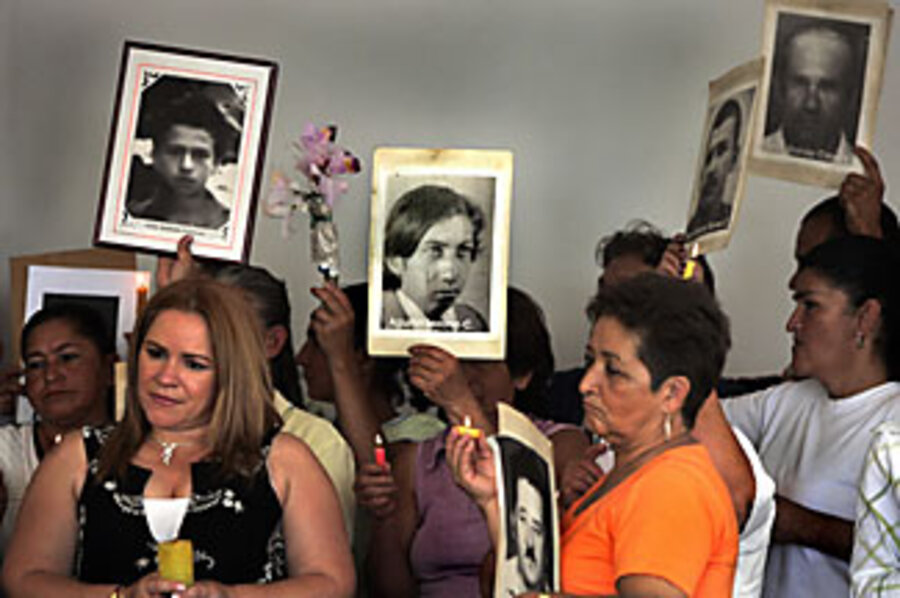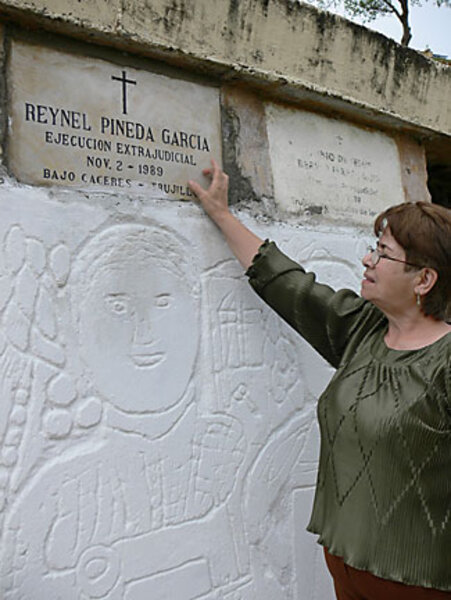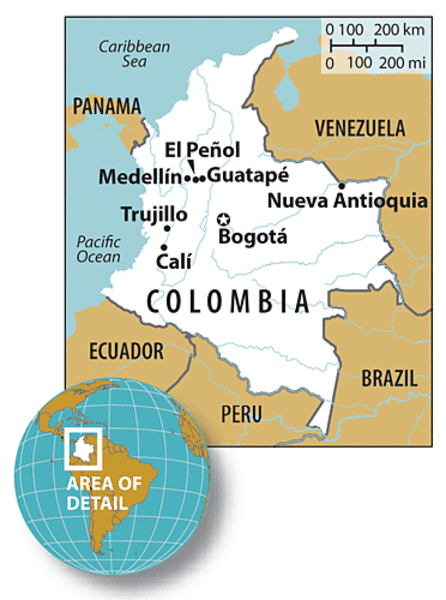To go forward, Colombia looks back
Loading...
| Trujillo, Colombia
For workers in this small town, Father Tiberio Fernández was a unifying force who helped them fight for their rights. For paramilitary chiefs and government forces, he was a rebel collaborator and a threat.
In 1990, he was kidnapped, tortured, dismembered, and dumped in a river, one of 342 victims in what came to be known as the Trujillo Massacre.
For years, most families of the victims of Colombia's four-decade-old civil war have quietly grieved and vented their anger among themselves.
Now their stories have become national news after last month's 300-page independent report on the Trujillo Massacre, the first of many intended to tell a fuller story of Colombia's hidden past.
In fractured, often uncoordinated, ways the victims – as well as former leftist guerrillas, former right-wing paramilitaries, and academics – are now reconstructing this nation's brutal history. Normally, this type of truth-seeking happens at the end of a conflict. Fear of retribution is a powerful silencer. But Colombians can't wait for peace.
"Society is demanding this now," says Gonzálo Sánchez, a renowned historian who leads the Historical Memory Group that compiled the report. He says Colombians want the truth and want to honor the victims.
Building an accurate record before a civil war is over poses a unique set of challenges. Prosecutions and truth-seeking before the end of a conflict have occurred elsewhere, such as in Darfur and Uganda. But these trials have been held in international courts and efforts to establish a record of events have been minimal.
Here, however, the urge to establish the truth is gaining momentum, even amid new murders, disappearances, kidnappings, and bombings. More than 10,000 leftist rebels remain at war, and many of the once-demobilized 30,000 paramilitaries are picking up arms again. Colombia is also in the process of trying some 3,000 former paramilitary and rebel fighters.
The result, in these strong crosscurrents, is often a messy affair.
"It's very hard to have the truth come out when the conflict is still in play," says Ginny Bouvier of the United States Institute of Peace, a congressionally funded organization in Washington. "It has a silencing effect on the population."
Mr. Sánchez acknowledges that many of the stories being made public by perpetrators and victims are only half truths. Often those who have dared to tell the whole truth have been threatened, killed, or coerced into changing their story. "The history that is being told is being told under threat," he says.
But Sánchez defends the effort. "Normally this type of effort marks the last step of a peace process to end a conflict," he says. "But maybe here it can be a starting point to a peace process, why not?"
More than a monument
In Trujillo, the first step toward seeking a personal peace was the construction of a terraced monument for victims' families to remember their loved ones. Beneath each name, relatives sculpted bas-relief images representing each person and what he or she did in life.
The monument is an effort by the families of the victims to keep the memory of their loved ones alive. But for survivors, remembering their own isn't enough.
"Constructing memory is about the desire to be recognized [as a victim] and understood by the people around you," says Louis Bickford, an expert on truth-seeking for the International Center for Transitional Justice in New York, an organization that assists nations in accounting for atrocities. "It is also an attempt to assure the nonrepetition of the crimes."
It's something Colombia has never done before, even after the bloody partisan war known as "La Violencia, or "the Violence" from 1948 to 1958 that claimed an estimated 200,000 lives.
When La Violencia ended, Colombia turned the page and looked forward, leaving victims' families bitter and angry and demanding justice.
"This is a country that was accustomed to ending its conflicts with wide-sweeping amnesties and pardons," says Sánchez. "The idea of victims barely existed, the dead were dead and that was it."
That's now changing. The Historic Memory Group has tallied 2,505 massacres in which 14,000 victims died between 1982 and 2007. The government has registered more then 145,000 deaths and disappearances, as well as more than 3 million internal refugees.
Under the so-called 2005 Justice and Peace Law, hundreds of demobilized paramilitary fighters and rebel deserters are confessing to thousands of those crimes in exchange for reduced sentences. This, observers say, is working as a catalyst for victims who are reporting their version of events for the first time.
Even though the conflict staggers on, the law presents "new opportunities to break the cycle of impunity," says Juan Mendez, president of the International Center for Transitional Justice in New York.
But the way victims and victimizers remember history often differs greatly. Sometimes, because of the official setting of the confessions, the former fighters are given more credence than to those who survived their crimes. That makes for what Sánchez calls the "asymmetry of history."
A victim confronts his attacker
At the Bogotá headquarters of Colombia's attorney general one recent morning, Miguel Páez waits impatiently to see the woman who ruined his life.
When Elda Neyis Mosquera – or "Karina" as she is known – is finally ushered into a court hearing room surrounded by bodyguards, he rushes up to her and growls: "Look at me. Remember me. Remember that you castrated me."
Karina, a former commander of a leftist rebel group who surrendered in May, bows her head and is whisked away to continue her confession of crimes committed during more than 20 years in the guerrilla movement. Some of her victims sit in a nearby room to watch a live video feed of the proceedings.
During the hearing, Karina denies having even been present in the region at the time of Mr. Páez says he was maimed by her. "That's not true. It was her," he says to others watching. "Her version cannot stand," says Páez, gritting his teeth. "I know my truth, and I will tell it to anyone who listens."
The 'battle for history'
Mr. Bickford at the International Center for Transitional Justice underscores the importance of giving value to the victim's versions. "If the victims do not tell their stories, the victimizers win the battle for history," he says.
On Oct. 1, in a court in Colombia's second-largest city, Medellín, Ana Eugenia Rojas narrowed her eyes and pursed her lips as she watched a live video feed of a former paramilitary commander who admited to ordering the killing of her son, Edgar Quiroga. But he described Edgar as an important rebel commander. "He was no guerrilla," she said. "They wanted him dead because he was helping farmers fight for their rights. That is how he needs to be remembered."
Despite the different versions of history, there are some details only the victimizers know, such as where the bodies of their victims are buried.
Confessions from paramilitary and guerrilla fighters have helped Colombian government investigators uncover the remains of 1,689 people from 1,389 clandestine graves this year.
On Oct. 3, investigating prosecutor Alonso Alvear added seven more bodies to the tally.
Early morning clouds cling to the hills as Mr. Alvear leads a team of forensics experts, escorted by dozens of police, over mud tracks deep into the countryside of Colombia's banana-producing Urabá region to a village called Nueva Antioquia.
Unearthing war stories
As the forensics team digs where a witness said three people had been buried in an unmarked grave 14 years ago, townspeople begin to approach the prosecutor to tell their own stories.
Victoriano González, a 65-year-old farmer, says he buried his son-in-law secretly in the graveyard, without reporting the death to authorities. In 2000, Udilde María Pastrana says she had her husband and her brother buried there as well.
She wants them to be registered as victims and wants to see if she can claim some of the $3.5 billion in reparation money the government has put aside in a special fund for victims in April.
Though controversial because victims will receive, at most, an average of $75 a month spread over the next 10 years, the incentive of reparation has lead many victims to shed their fear.
"We were too scared back then to say anything," says Ms. Pastrana. "Standing here, today, I'm still afraid, but not so much."
But despite the continued fear, Sánchez says, people are willing to talk. "They are establishing the memory; they are pushing the limits imposed by the continued violence," he says.
The Historical Memory Group's report relates the details of the 1990 Trujillo Massacre with surprising candor.
It tells of a pact between the local Army commander and two leading drug lords. Their goal? Break the back of rebels who were trying to extort money from drug runners. It recounts the testimony of eye-witnesses who saw an Army major wield a chainsaw against his victims, a method later to be reproduced throughout the country by paramilitary groups.
Orlando Vargas was a 26-year-old carpenter at the time, when he and two of his brothers were snatched from their workshop on one corner of Trujillo's main square along with two assistants. They were never seen again.
Yamileth Vargas, his oldest child, was only 4 at the time. She grew up without her father, but his memory was kept alive within the family. "My father was a daily topic of conversation for us," she says today. "We talked of him all the time, not just about his death but about his life."
Henry Loaiza Ceballos, a drug lord known as "The Scorpion," and Army major Alirio Urueña, oversaw the torture and killing of Vargas's father and the other carpenters at a ranch called Las Violetas, according to the report.
This was not news to Ms. Vargas, now a lawyer who handles victims' rights cases. But it was important to her that the official history reflect the truth because, she says, nearly 20 years later, no one has been convicted of the crimes.
That may change now. Following the presentation of the Historical Memory Group report, Colombia's attorney general ordered all related cases transferred to Bogotá, and warrants have been issued for 20 police and Army officers as well as the husband of the current mayor.
Vargas says that, for her, this is the first step toward closure. "The ultimate step will be when the criminals are convicted."
The Historic Memory Group's mandate does not give it the sweep of an official truth and reconciliation commission like those in more than 30 other countries, and it plans to study only a few emblematic cases of particularly heinous crimes.
Eventually, however, the reports it produces could serve as a basis for the work of a full-fledged truth commission, the creation of which is being currently discussed at the same time Congress debates a bill known as "The Victims Statute."
The bill, if approved, would provide for the restitution of stolen land and set up a national museum of violence and an armed conflict archive.
Spontaneous historians
But many communities are not waiting for a commission to write their histories. In Guatapé, a small, brightly painted town in Antioquia province, victims are just now getting organized.
When they get enough money, says Sonia Díaz – whose father and brother disappeared in 2005 – the group wants to build a public monument with the names of all of the town's victims and they plan to write their stories in a "Book of Memory."
For now, all they have is a sheet of white plastic on a painted tree with the names of the dead interspersed among the leaves and the names of the disappeared near the trunk.
It is a modest first step to recreating a public record of their loved ones, so that the crimes committed against them will not be forgotten.








